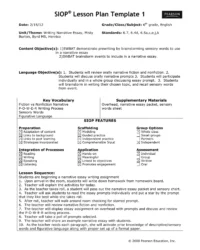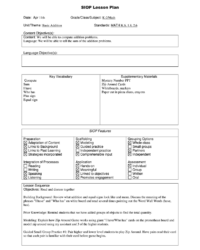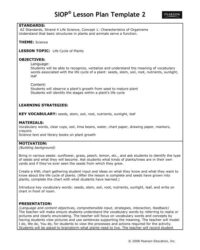Are you a teacher dedicated to ensuring every student, especially those learning English, thrives in your classroom Imagine a teaching approach that systematically supports English Language Learners ELLs by making academic content comprehensible while simultaneously developing their language skills. This is exactly what sheltered instruction aims to achieve, and at its heart lies the Sheltered Instruction Observation Protocol SIOP Framework. It’s not just a set of guidelines; it’s a proven model designed to enhance teaching practices and improve academic outcomes for diverse learners.
The SIOP Model breaks down effective sheltered instruction into eight interconnected components, providing a comprehensive framework for lesson planning and delivery. While understanding these components is crucial, putting them into consistent practice can sometimes feel overwhelming. This is where a well-designed template becomes an invaluable tool, transforming abstract principles into concrete actions that guide your daily instruction. It helps ensure that every critical aspect of sheltered instruction is thoughtfully considered and woven into your lesson design.
Understanding the Core of Sheltered Instruction
The SIOP Model is a research-based instructional framework that has significantly impacted the field of English language education. It provides teachers with a systematic and coherent approach to planning and delivering lessons that are specifically tailored to the needs of ELLs, regardless of their proficiency levels. Think of it as a blueprint that guides educators in creating dynamic and supportive learning environments where language acquisition and content mastery go hand in hand. It moves beyond simply modifying assignments; it’s about intentionally integrating language development into every subject area.
Using a structured approach like the SIOP framework helps teachers make informed decisions about lesson content, instructional strategies, and assessment methods. It encourages a proactive mindset, pushing educators to anticipate potential language barriers and implement scaffolding techniques before they become obstacles. The ultimate goal is to bridge the gap between academic content and language proficiency, ensuring that ELLs can access the curriculum and participate fully in classroom activities, leading to greater academic success.
A template based on this robust framework isn’t just a checklist; it’s a living document that prompts you to consider all the nuances of effective instruction for ELLs. It guides you through the process of articulating clear content and language objectives, selecting appropriate materials, and designing engaging activities that promote both understanding and language use. It serves as a reminder to always keep the language demands of the lesson in mind, helping you to explicitly teach vocabulary and grammar within the context of the subject matter.
By consistently applying the principles embedded within a SIOP-aligned template, you foster an inclusive classroom where every student feels supported and challenged. It empowers you to deliver high-quality instruction that not only imparts knowledge but also builds essential communication skills, preparing your students for academic and real-world success. This systematic planning ensures that no critical element is overlooked, leading to more impactful and equitable learning experiences for all.
Key Components a SIOP Lesson Plan Should Address
- Lesson Preparation: Clearly define content and language objectives, adapt materials, and select meaningful activities for diverse learners.
- Building Background: Connect new concepts to students’ prior knowledge and experiences, and explicitly teach key vocabulary.
- Comprehensible Input: Use appropriate speech, explain tasks clearly, and employ a variety of techniques to make content understandable.
- Strategies: Incorporate scaffolding, promote higher-order thinking, and teach students how to use learning strategies.
- Interaction: Provide opportunities for meaningful interaction, promote extended speaking, and use effective grouping configurations.
- Practice and Application: Offer hands-on experiences, integrate all language skills, and apply content and language knowledge.
- Lesson Delivery: Maintain appropriate pacing, engage students actively, and provide clear and consistent feedback.
- Review and Assessment: Systematically review key vocabulary and concepts, and assess student learning formally and informally.
Developing a Practical Sheltered Instruction Observation Protocol Lesson Plan Template
Crafting your own sheltered instruction observation protocol lesson plan template isn’t just about filling in blanks; it’s an opportunity to deeply reflect on your instructional practices and tailor them to the specific needs of your students. Think about it as designing a personalized roadmap that guides you through each lesson, ensuring that every crucial aspect of sheltered instruction is intentionally addressed. This proactive approach helps you anticipate potential challenges and integrate strategies that support language acquisition from the outset.
The beauty of a customizable template is its flexibility. While the core components of the SIOP Model remain constant, how you interpret and apply them can vary based on your subject, grade level, and the unique linguistic profiles of your students. Don’t be afraid to adapt and refine your template over time as you gain more experience and insights. It should be a dynamic tool that evolves with your teaching practice, making it more effective and efficient with each use.
Ultimately, your personalized template serves as a powerful reminder of the commitment to provide equitable and effective instruction for all learners. It transforms the comprehensive SIOP framework into a practical, everyday tool that helps you plan with precision and confidence. This thoughtful preparation ensures that every lesson not only delivers academic content but also actively fosters the language development critical for your students’ long-term success.
- Start with clear learning objectives for both content and language.
- Integrate culturally relevant materials to engage students.
- Plan for differentiated instruction to meet varied proficiency levels.
- Include specific strategies for checking comprehension throughout the lesson.
- Allocate time for student interaction and collaborative work.
- Design assessments that truly measure both content and language acquisition.
Implementing a systematic approach to lesson planning, especially one informed by the SIOP Model, significantly enhances the quality of instruction for English Language Learners. It moves beyond accidental support to intentional design, ensuring that every element of your lesson contributes to both content mastery and language development. This deliberate planning creates a more accessible and enriching learning environment for all students.
The consistent use of such a planning tool empowers educators to deliver engaging, effective, and equitable instruction. It helps teachers to not only meet the diverse needs of their students but also to cultivate a classroom where language learners feel confident, supported, and ultimately, successful in their academic journey.


